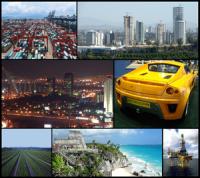
Going clockwise and starting from the upper left image: Port of Veracruz, Puerta de Hierro in Guadalajara Business District, Mastretta MXT automobile by Mexican automaker Mastretta, Pemex Oil platform in the Gulf of Mexico, Ancient city of Tulum, Crops, City of Monterrey
|
| Country | Mexico |
| Width | 300px |
| Caption | Going clockwise and starting from the upper left image: Port of Veracruz, Puerta de Hierro in Guadalajara Business District, Mastretta MXT automobile by Mexican automaker Mastretta, Pemex Oil platform in the Gulf of Mexico, Ancient city of Tulum, Crops, City of Monterrey |
| Currency | Mexican peso (MXN, $) |
| Year | calendar |
| Organs | APEC, NAFTA, OECD and WTO |
| Rank | 13th (nominal) / 11th (PPP) |
| Edbr | 35th |
| Gdp | $1.004 trillion (nominal; 2010)
$1.550 trillion (PPP; 2010) |
| Growth | 5.5% (2010) |
| Per Capita | $9,243 (2010) (nominal)
$14,265 (2010) (PPP) |
| Sectors | agriculture: 4%, industry: 26.6%, services: 69.5% (2007 est.) |
| Inflation | 3.6% |
| Poverty | 18.2% using food-based definition of poverty; asset based poverty was approximately 47% (2008) |
| Gini | 50.9 (2005) |
| Labor | 44.71 million (2007 est.) |
| Occupations | agriculture: 18%, industry: 24%, services: 58% (2003) |
| Unemployment | 6.2% plus considerable underemployment (26%) (2009) |
| Industries | Food and Beverages, Aerospace, Electronics, Tobacco, chemicals, Iron and Steel, Petroleum, Biotechnology, Mining, Shipbuilding, Electricity, Defense Products, Textiles, Clothing, Motor vehicles, Computers, consumer durables, Information Technologies, Tourism and Ecotourism |
| Exports | $303 billion f.o.b. (2010 est.) |
| Export-goods | Manufactured goods, electronics, oil and oil products, aircraft, silver, computers and servers, fruits, meats, consumer electronics, processed foods, vegetables, ships, coffee, LCD screens, electricity, biotechnology, cotton, rolling stoc, automotive and aircraft enigines, cellular phones, metals, industrial equipment, granite and marble, lithium, batteries |
| Export-partners | US 76.5%, Canada 6%, Germany 1.7% (2008) |
| Imports | $306 billion f.o.b. (2010 est.) |
| Import-goods | steel mill products, agricultural machinery, electrical equipment, repair parts for motor vehicles and aircraft parts |
| Import-partners | United States 56.7%,
China 9.35%,
South Korea 5.21%,
Japan 4.1% (2009) |
| Debt | $341 billion (December 2010) |
| Revenue | $233 billion (2010) |
| Expenses | $262 billion (2010) |
| Reserves | US$128.299 billion (March 2011) |
| Credit | *Standard & Poor's:
A (Domestic)
BBB (Foreign)
A (T&C Assessment)
Outlook: Stable
*Moody's:
Baa1
Outlook: Stable
*Fitch:
BBB
Outlook: Stable |
| Aid | $189.4 million (2008) |
| Cianame | mx |
|
|
The economy of Mexico is the 13th largest in the world in nominal terms and the 11th by purchasing power parity, according to the World Bank.
Since the 1994 crisis, administrations have improved the country's macroeconomic fundamentals. Mexico was not significantly influenced by the recent 2002 South American crisis, and maintained positive, although low, rates of growth after a brief period of stagnation in 2001. However, Mexico was one of the Latin American nations most affected by the 2008 recession with its Gross Domestic Product contracting by more than 6%. Moody's (in March 2000) and Fitch IBCA (in January 2002) issued investment-grade ratings for Mexico's sovereign debt. In spite of its unprecedented macroeconomic stability, which has reduced inflation and interest rates to record lows and has increased per capita income, enormous gaps remain between the urban and the rural population, the northern and southern states, and the rich and the poor. Some of the government's challenges include the upgrade of infrastructure, the modernization of the tax system and labor laws, and the reduction of income inequality.
The economy contains rapidly developing modern industrial and service sectors, with increasing private ownership. Recent administrations have expanded competition in ports, railroads, telecommunications, electricity generation, natural gas distribution and airports, with the aim of upgrading infrastructure. As an export-oriented economy, more than 90% of Mexican trade is under free trade agreements (FTAs) with more than 40 countries, including the European Union, Japan, Israel, and much of Central and South America. The most influential FTA is the North American Free Trade Agreement (NAFTA), which came into effect in 1994, and was signed in 1992 by the governments of the United States, Canada and Mexico. In 2006, trade with Mexico's two northern partners accounted for almost 90% of its exports and 55% of its imports. Recently, the Congress of the Union approved important tax, pension and judicial reforms, and reform to the oil industry is currently being debated. According to the Forbes Global 2000 list of the world's largest companies in 2008, Mexico had 16 companies in the list.
The annual Mexico Investment Summit takes place in Mexico City covering the development and investment opportunities and challenges across Mexican private equity, venture capital, infrastructure, real estate, agriculture, tourism, energy and natural resources evolving in the country's economy.
|
|
|




 RSS
RSS